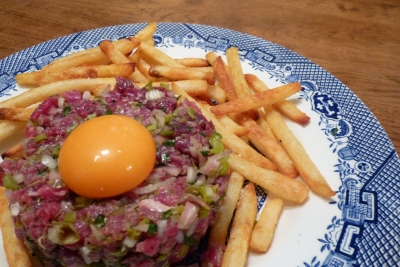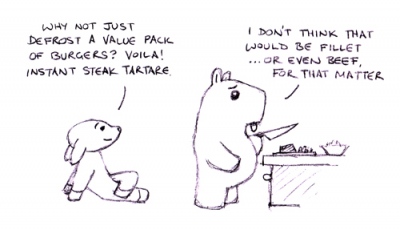Whenever I visit France I throw myself at the steak tartare like a love-struck fool. Because absence makes the heart grow fonder and this simple dish is harder to find on UK menus than beetroot macarons. Not impossible, I grant. But don’t bother telling me about the one posh brasserie in London you know of that has it on occasionally; in France you find steak tartare in family-friendly chain restaurants and every cheap bistro in every single town.
Clues as to why I can’t find steak tartare in the UK are plentiful. Search for recipes and they all agree on one thing: use the very best fillet steak. Ouch. That’s immediately pushing it out of the everyday bistro food category. Were my 10 euro steak tartares around rural France really all fillet?
Next we can search the web for articles discussing the pros and cons of eating raw beef. Opinions are polar, running from “I love the taste of raw beef, chicken, turkey…” right through to “I think it’s disgusting! I actually don’t know how people can casually chomp on raw meat! I find it repulsive.” Taken on balance, the “think it’s disgusting” group seem to have weight of numbers. And I’m betting they represent an even larger silent majority who would simply never think of eating raw beef.
I’m part of quite a small market, it’s no wonder most restaurants won’t risk their fillet steak on it. Chatting on Twitter, Matt Follas of The Wild Garlic told me that last time he tried, he offered it raw or grilled… and every order was for grilled. Hmm.
Finally, it’s interesting to look at Food Standards Agency advice. Their requirement is that if you have to serve steak tartare (reading their blogs and articles, it’s pretty clear they would much rather all meat was cooked right through) you must use the “sear and shave” approach; sear the outside of the beef and then cut the seared edges away, before mincing the interior.
So that’s a fair percentage of your fillet steak disappearing into the bin.
To be fair their fear is E. coli, a particularly horrible bacteria that exists naturally in cattle guts and faeces. Apparently no modern beef butchering process can entirely avoid getting some of this onto the surface of the meat. Which means that any beef, even the best fillet from your local organic butcher, could have a little E. coli dusting the surface. Fear not, a brief searing will kill it entirely, which is why even rare steak should be safe and why “searing and shaving” the steak before chopping it for tartare is also safe.
But do they really take this approach at every tiny neighbourhood bistro in France?
I suspect not. I also suspect that farming practise has something to do with it. Modern mass production of beef cattle is intensive. The beef live their lives in small concreted yards where they are fed corn and dosed with numerous additives to try and keep them healthy. Hardly the cleanest animals at the best of times, they are essentially standing around 24/7 in each other’s muck. Where the E. coli is found. My hunch is that the highly subsidised French agricultural system has a lot more grass-fed cattle living out in the fields. Your average French bistro sourcing meat from their average French butcher is probably getting a better product than the average UK restaurant getting a weekly delivery from a meat wholesaler. Not every restaurant in the UK can afford premium beef from the minority of farms using less intensive practises.
I hoped this post would be an entertaining rant against bonkers food safety standards, but I’ve ended up concluding that there probably is a higher risk from eating steak tartare in this country than in France. That’s reality. What I cannot hope to self-research is the absolute risk of finding E. coli on a piece of raw beef. The risk exists, as evidenced by the occasional news stories of an outbreak, and although these stories always seem to relate to undercooked burgers of dubious provenance that doesn’t mean there is zero risk from a carefully sourced piece of fillet. But I think it’s pretty low.
So if – for the sake of argument – the risk of finding E. coli in a well-kept piece of beef is substantially less than the risk of being killed in a car crash then I’m going to keep enjoying steak tartare and driving to work.
How? Well, since restaurants won’t give it to me I’m going to make it myself.
Steak tartare (serves 2)
2 fresh egg yolks
1 banana shallot
1 tbsp capers
4 cornichons
Handful flat-leaf parsley
2 tsp Worcestershire sauce
Dribble of olive oil
Splash of Tabasco sauce
Salt and black pepper
- Remove any obvious bits of fat, then chop your steak up very fine, just stop short of turning it into mince
- Finely chop the shallot, capers, cornichons and parsley
- Mix these into the steak along with the Worcestershire sauce, Tabasco to your taste, olive oil if a little dry, then salt and pepper to season
- Divide the steak tartare between two plates (I used a big cookie cutter as a mould and squished the tartare into it, which looks nice), add an egg yolk to the top of each, and pile a load of salty French fries alongside. Bliss!
If you are more concerned about E. coli than I, just buy 400g of steak and sear every side of it in a pre-heated frying pan (2 seconds is fine) before carefully slicing the seared edges off. Then switch to a new chopping board and new knife to dice up the beef.
Buying your steak
Please, please, please don’t try making steak tartare with meat from your local supermarket. Yes, I know that sounds very middle class, but I’ve seen far too much TV exposing the slip-shod and cost-squeezed supply chains that get produce onto supermarket counters to ever trust their meat raw. Instead I went to a reputable (in fact, award-winning) local butcher and explained that I wanted to do steak tartare. They suggested two tail-end pieces of fillet steak; being too thin to make steaks they were cheaper but still as lean as the rest of the fillet and in fact more full-flavoured. Brilliant! That’s what going to someone knowledgeable gets you. Thank you, Ludlow Food Centre.





8 pings
Skip to comment form ↓